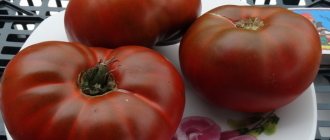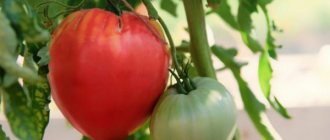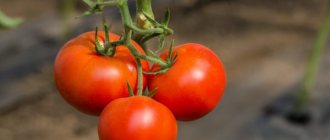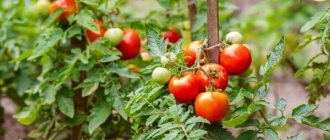Tomato Dark Tiger pleases the eye with its unusual color. In addition, it contains tons of nutrients, and anthocyanins are also beneficial. Its taste has earned a lot of positive feedback from gardeners.
| Height | Pick-up location | Ripening terms | Fruit color | Fruit size | Origin | Fruit shape |
| Tall | Greenhouse, Open ground | Mid-season | Bicolor | Middle | Variety | Round |
Description of the tomato variety Tiger cub and cultivation features
Tomato Tiger cub - this variety of tomatoes was developed by Russian breeders for open ground and film greenhouses. And although this vegetable crop appeared on the market relatively recently, there are more and more people who want to plant tomatoes of original color every season.
Vegetable growers are attracted by the exotic color of ripe fruits, reminiscent of the skin of a tiger cub (it is not without reason that the variety got such a name), a fairly high yield of bushes, and excellent marketability and taste of the harvested crop.
Description and characteristics of the variety
The tiger cub belongs to the indeterminate type, the bushes are tall, well-branching, the shoots are moderately leafy, erect, up to 1.4-1.6 m high, the foliage is simple, medium-sized, typically tomato, emerald in color.
Shoots should be pinched off to stop the growth of the vegetative part of the bushes. Despite the medium size of ripe tomatoes, tall stems require a garter to the trellises (or supports). In order for the crop to fully ripen, the bushes should be formed into no more than 3 stems. Be sure to regularly remove side shoots and stepchildren.
Tomatoes Tiger cub are mid-season varieties - more than 3.5 months pass from the moment the shoots emerge to harvest. The first ovaries are formed at the level of 4-5 permanent leaves, the next inflorescences are formed after 2-3 leaves. Inflorescences are racemose, in each of the brushes 8 to 12 fruits ripen.
The shape of ripe tomatoes is round, similar to typical apples, weighing 40-80 g. The flesh is fleshy, juicy. The skin is firm, not prone to cracking. The color is red with orange stripes, reminiscent of the skin of a tiger. Taste qualities are high, fruits are sweet with a slight sourness. In rainy, cold seasons, the fruit grows more acidic.
This variety is characterized by a high yield - more than 10 kg of ripe tomatoes are harvested from 1 m². The harvested crop tolerates transportation well, ripe tomatoes are distinguished by high keeping quality, and during the storage period neither marketable nor taste qualities deteriorate. Harvested tomatoes are universal: due to their unusual appearance and excellent taste, they will decorate any table, look good with whole canning, you can also prepare delicious tomato juice and tomato puree.
Tomato variety Tigrenok is highly resistant to most fungal diseases, in particular to late blight and gray rot.
Fruit
They are very beautiful! In the photo, I saw directly completely striped, really similar to the skin of a tiger or St. George's ribbon. I didn't grow up like that, but there was a pleasant play of dark red, pinkish-scarlet and purple hues.
Ribbed tomatoes, roundish in shape.The skin is quite thin and I like it - I used to cut them into salads with pleasure. And the family devoured them, too, accordingly, with pleasure.
These tomatoes have a rather high acid content, so I gladly made vegetable kebabs out of them, added them to meat, cooked tomato sauce. I did canned food. Quite!
The sunnier the place where you put your "tigers", the more beautiful the color will be. They love the sun very much. The weight of a tomato is from 150 to 300 grams. If you do everything correctly and take good care of the bushes, you will get a harvest of 3.5 kg per bush.
What does “right” mean? I'll explain now:
- Do not get too carried away with breaking off the leaves: the leaves provide the fruit with everything useful and nutritious, do not harm your tomatoes with excessive zeal.
- Remember to ventilate the greenhouse. Even such heat-loving "Americans" do not like excessive heat - it should not be more than 32 degrees.
- Be careful with fresh manure - instead of a large harvest of fruits, you will get a huge harvest of leaves and stepsons. And the fruit is good if you collect a kilogram.
- The best "predecessors" of the variety are legumes, cucumbers, cabbage, carrots.
- Don't forget to pinch! Otherwise, you will have a violent jungle with stunted fruits: everything will go into greenery.
- Do not flood the bushes - this variety does not like excessive moisture.
- Little secret: when all the fruits on the first cluster are ripe, cut off all the leaves above it. Do this throughout the ripening period. But do not tear more than 4 leaves per bush per week.
Read also: Tomato varieties resistant to late blight for greenhouses
Advantages and disadvantages of the variety
Every season vegetable growers leave their reviews on the forum of this variety - those who planted Tiger cub tomatoes give advice on growing seedlings and transplanting them in open ground, and also talk about the pros and cons of this vegetable crop.
The obvious advantages of this vegetable include:
- high yield of the variety;
- beautiful appearance of ripe tomatoes; high commercial and taste qualities;
- good transportability and long shelf life;
- the versatility of the harvested fruits.
There are practically no drawbacks to this vegetable crop, only shoots should be tied up and pinched regularly. In general, the variety showed itself excellently both when growing in beds and in conditions of film greenhouses.
Description of tomatoes Tiger cub
Consider the description and characteristics of the variety. The plant is indeterminate. Tomato bushes are relatively tall, well branched, branches have a small number of leaves, erect shoots, their height reaches 1.5 m.
The leaves are emerald in color and medium in size. When growing, the bushes must be shaped. Gardeners pinch the top of the plant to prevent overgrowth of the vegetative part.
A plant with high stems must be tied to a support or trellis. Bushes need to be pinned so that 3 stems are formed. You constantly need to pinch the side branches and stepsons. Tomatoes of this type are mid-season varieties.
From the moment the seedlings develop to the ripening of the crop, it takes about 3.5 months. After the formation of 4-5 leaves, the first inflorescences are formed. The rest of the ovaries are formed in 2-3 leaves. The ovaries have the shape of a brush, each of them ripens about 8-12 tomatoes.
The fruits are round in shape and resemble apples in color and appearance. The weight of one fruit is 40-80 g. Tomatoes have a juicy, dense pulp. The skin of tomatoes is dense, does not crack. The color of ripe specimens is red with orange stripes, they are similar to the color of the skin of a tiger cub.
Description of the Siberian tiger tomato
The Siberian Tiger tomato was created by US breeders under the leadership of Mark McCaslin by crossing two other types of tomatoes - the King of Beauty and the Blue.This vegetable belongs to the indeterminate species and is rightfully considered an exotic variety. This tomato is included in the State Register in 2020.
Description of the Siberian tiger tomato:
- the plant is tall and when grown indoors, its height can reach 1.5-2 m;
- leaves are long, thick, bright green;
- average foliage;
- inflorescences of the intermediate type are quite powerful, with a large number of ovaries - 3-7 pieces per stem;
- up to 6-8 tomato clusters are formed on one shoot.
Description of fruits
The fruits of the Siberian tiger tomato found in our country have a rounded shape, resembling a ball or semicircular. The skin of the tomatoes is smooth. But vegetables of American selection have a peculiar ribbing. The structure of the fruit is dense, the flesh is tender and fleshy, the skin is thin.
The color of unripe tomatoes is light green, with characteristic stripes. It is thanks to them that the variety got its name - "Siberian Tiger". These stripes make the tomato look like an animal's skin. Fully ripe tomatoes are purplish pink with prominent black lines. Tomato shoulders at the stalk with a blue-violet tinge.
The average weight of a ripe tomato is about 150-200 g, on the first cluster up to 300-400 g. The fruits of the Siberian tiger are multi-chambered, with a large number of medium-sized seeds. The tomato pulp is red, with a sugary structure at the fracture. The taste of tomatoes is sweetish, with a pronounced fruity aroma.
Taste qualities of tomatoes
Tomatoes have excellent taste. Tomatoes are sweetish with a slight sourness. If the plant has received little sunshine and heat, or has grown in cold weather or rainy periods, the fruit will be more acidic.
Tomatoes Tiger cub have a high yield. About 10 kg of tomatoes can be harvested from 1 m². Tomatoes tolerate transportation well and are well stored for a fairly long period. During the entire storage period of these tomatoes, their excellent taste and appearance remain unchanged.
Tomatoes can be used fresh, canned, used for making sauces, gravies, seasonings. They can be fried and boiled, used to prepare various dishes. Thanks to their original color and excellent taste, these tomatoes look great if they are whole pickled.
The plant is hardy and resistant to various diseases such as late blight and gray rot.
Tomato characteristic
When planting a tomato of the Siberian Tiger variety in the southern strip, you can get an excellent harvest in the open field. In the middle and northern latitudes, it is better to grow this tomato in greenhouses and film shelters, since its fruits do not tolerate cold temperatures well.
Productivity and fruiting
The mid-season Siberian tiger variety - technical maturity occurs in 110-120 days from the moment of emergence. With proper agricultural technology, you can achieve good yields: from 1 bush - 3-4 kg, and from 1 sq. m - up to 12 kg.
Recommendations for increasing the tomato yield Siberian tiger.
- Tomatoes love fertile, light soils. The best predecessors are beans, carrots, cucumbers and cabbage.
- It is not recommended to plant tomatoes in the same place earlier than 2-3 years later.
- When growing crops in a greenhouse, it is necessary to monitor the temperature regime. Temperatures exceeding plus 32 can be detrimental to tomatoes. It is also important not to forget about airing.
- Do not use fresh humus. This can enhance the growth of stepchildren and large leaves, while the stem, on the contrary, will become thinner. Fruits will set harder and grow more slowly.
- It is necessary to remove stepchildren in a timely manner, otherwise part of the harvest will be lost.
- Tomatoes do not like excess moisture, so do not overuse it with watering.
- To increase the ovary, the bushes can be sprayed with boric acid (0.02% solution).
- Do not abuse the breaking of leaves in order to increase the yield.Without these actions, you can get the opposite effect. After all, the leaves provide the plant with useful substances and vitamins. Only diseased and damaged leaves should be removed on tomatoes.
Scope of the fruit
Tomatoes of the Siberian Tiger variety can be eaten both fresh and for preparing a variety of dishes. From ripe tomatoes it is easy to prepare canned salads for the winter, lecho, ketchups, sauces, adjiki, Spanish gazpacho soup, tomato paste and juice. You can add them to salads, stews, soups, pizza. Due to the high content of acids in the fruits, they are harmoniously combined with meat dishes both fresh (as a side dish) and in the form of sauces and marinades.
Disease and pest resistance
The Siberian tiger has a strong immunity to the development of many viral, infectious and bacterial diseases. Bushes are not attacked by various pests. If you follow all the recommendations for growing and caring for tomatoes of this variety, you do not have to worry about any problems with productivity.
Advantages and disadvantages of the variety
Based on the description of the variety and reviews of gardeners about the yield, it is possible to distinguish both the advantages of the Siberian tiger tomato and its disadvantages.
- exotic coloring;
- excellent and unusual taste characteristics;
- can be grown both indoors and outdoors;
- large fruit weight;
- a large number of ovaries are formed;
- fruits are not prone to cracking when watering;
- tomatoes hold well on the stalk when overripe;
- resistance to overripe cracking;
- versatility of fruits;
- high productivity.
Every vegetable has its drawbacks. This variety is no exception. Disadvantages of Siberian Tiger Tomato:
- the plant is tall, so its growth has to be restrained by pinching the top of the main stem;
- the need to tie up not only the stems, but also the bunches;
- needs pinching, since it is recommended to form a plant only in 1-2 stems, so as not to overload;
- the fruits have a thin skin, so the variety is not suitable for whole-fruit canning;
- The Siberian tiger is not very suitable for transportation. Delicate skin is severely damaged from any physical influences, therefore, they should be placed in boxes carefully and neatly, in one row;
- the harvested crop is not stored fresh for a long time;
- in a warm climatic zone, all clusters ripen, even when grown in the open field. In other latitudes, this variety is preferable to grow in greenhouses.
Reviews of gardeners
The reviews of those who planted this variety are positive. As the advantages, gardeners note:
- high productivity;
- exotic appearance of the fruit;
- great taste;
- good safety during transportation;
- long storage period.
Among the disadvantages of the variety, those who grew these tomatoes note that the plant requires a garter and regular formation of bushes. Tomatoes Tiger cub grow well both in the open field and in greenhouses. For example, the hostess who planted these tomatoes received 30 kg of fruit from a small garden in her summer cottage.
Description and characteristics of the variety
Description of the bush
Tomato Tiger forms bushes up to 1.5 meters. Erect stems branch well, forming medium-sized foliage. Fast-growing shoots are pinched to stop the growth of green mass. Then more nutrients will be spent on ripening the fruits.
Long stems are fixed to a trellis or other support. To obtain the maximum yield, it is desirable to form 2-3 stems, removing stepchildren.
Description of fruits
Interest in the variety arose due to its unusual colors. Small, round, red tomatoes with yellow stripes, reminiscent of the color of a tiger. The skin is dense, its integrity is preserved when ripe. Tomatoes hold tight, rarely fall off the stalks. The pulp is juicy and fleshy.The taste is sweet, with a slight sourness.
The variety is mid-season. The period from sowing seeds to the first harvest is 110–120 days. The first group of ovaries is formed at the level of 4–5 permanent leaflets.
The next inflorescence is formed after 2-3 leaves. A group of flowers forms a brush, where 4–6 ovaries ripen. Each tomato weighs 30-50 grams. 6–7 brushes grow on one stem.
Description of the variety "Siberian tiger"
And it was not at all created in Siberia, as it turned out, but in one of the warmest countries in the world - the United States. This is an outspoken hybrid and treat it differently, not everyone approves. But it’s too handsome! American breeder Mark McKaslin got this species from a cross between the King of Beauty and Blue.
This variety is indeterminate - that is, it will grow indefinitely if the top is not removed. And you will have to wade in your own greenhouse with a machete in hand. I removed the tops and limited the growth of the bush. The variety is mid-season, that is, the fruits ripen three to four months after germination.
At home in America and in our south, "tigers" can be planted in open ground. But I live in the Urals and here is just a greenhouse. It turned out to be heat-loving "Siberian tiger". It is imperative to tie up! Stepson, of course, too. Then a lot of fruits will grow on one stem - 6 or 7 brushes. Let you have 1-2 stems, no more.

Characteristics of the variety
Possesses excellent productivity, from a plot of 1 sq. M. collect 5 kg or more. Long fruiting and shelf life will increase the harvesting period. Storage does not impair the appearance and taste. The crop is well transported. Tomatoes are small, rounded, with a thick skin. It is successfully consumed fresh, frozen, canned, both whole fruits and in the form of juice.
Tomato Tiger is resistant to many diseases, especially to late blight, gray rot.
Seed sowing dates
Varietal tomatoes The Amur tiger should first be sown on seedlings, and then planted in a permanent place. Taking into account climatic differences in different zones, the seeding time also changes. Before planting in the ground, the tomato remains in the room for 55-60 days. At this point, the roots are formed, and the plants have the strength to grow further.
The recommended planting dates for seeds are from March 20 to April 10. In a warm spring, the sowing time shifts 5 days ahead, but no more. However, if the soil in the garden does not warm up quickly enough, then you can plant seeds at the end of April. At the same time, the fruiting period of tomatoes is also shifted.
The advantages and disadvantages of tomato
Many reviews about the taste and cultivation characteristics characterize the variety well both in indoor and outdoor conditions.
Benefits for growing:
- original appearance of tomatoes;
- good productivity;
- sweetish, juicy taste;
- safety of presentation during maturation, storage, transportation;
- different ways of eating fresh and canned.
Among the shortcomings, the high growth of shoots is noted, which must be pinned and tied up. But in general, the characteristic of the variety allows you to get a generous harvest in the greenhouse and outdoors.
Pests and diseases
Tomatoes of the Siberian Tiger variety have a fairly strong immunity to many common diseases. Plants are not susceptible to attack by various pests.
If you follow all the recommendations for growing and caring for tomato bushes of this variety, then you do not have to worry about any problems with the harvest.
But if the rules for watering are violated and there is a lack of daylight in greenhouses and hotbeds, the leaves of the culture can be affected by powdery mildew.
Whitefly and aphids are fought with the use of a spray solution "Confidor":
- In 10 liters of water, dilute 1 ml of the product and spray on the seedlings.
- It is enough to distribute this amount of solution over the planting area of 100 m2.
As well as for other nightshade crops "Siberian Tiger" responds well to periodic loosening of the soil, to allow air to reach the roots and prevent them from decay. The variety needs a lot of light, especially during the ripening period.
If all these simple conditions are met, tomato bushes will not only not get sick and be attacked by pests, but also give a tasty harvest in large enough quantities.
Varietal Amur tiger tomatoes are highly resistant to diseases of nightshade crops. Only late blight is dangerous for tomato. To prevent the disease, ventilation and a constant flow of warm air in the greenhouse should be established. Before flowering, the bushes are treated with fungicides.
Subject to the rules of agricultural technology, plants are not susceptible to pest infestation. Tomatoes should not be grown in the same location. To protect the crop, disinfection of seeds harvested by yourself, or purchase of planting material from a reliable manufacturer will help.
Pest infestation is not terrible for those crops that grow outside the environment of weeds. Gardeners need to periodically go to the site for weeding. If there is no time for this, the land is mulched. Prevention of some diseases may be advisable, given the weak resistance of the bushes in relation to diseases such as bacterial spotting and different types of mosaics.
Testimonials
Irina Sergeevna
I have been planting a Tiger tomato for many years. Small striped tomatoes my kids love. I grow from my seeds, sometimes I update and buy in the store. I sow and grow seeds on the windowsill, and then transplant them into open ground. The cultivar matures on site, although some large cultivars do not always ripen. Resistant to late blight.
Victoria
I studied the description of the Tigrovy variety, became interested in the multi-colored color of the fruits, decided to try to grow it. Tomato bushes are tall. Tomatoes with a sweetish taste. The yield is excellent, almost a bucket from a bush. When salted, ripe fruits crack, but green-brown ones look beautiful. Keeping quality is average.
> Tiger Tomato


photo by Natalia Pashchenko
Planting and leaving
The soil for planting tomatoes is prepared in the fall, but sometimes, for various reasons, this did not work out, and then all the work is done in the spring, no later than two weeks before planting. No more than 4 bushes are placed on one square meter, the distance between the holes should not be less than 50 cm.
The Siberian Tiger variety perfectly responds to soil mulching, such a procedure prevents weeds from growing and retains moisture in the soil. It is recommended to pick off the lower leaves to ensure air circulation. The bush is formed into 2-3 stems, stepchildren must be removed once a week.
It is recommended to fertilize tomatoes of this variety with organic fertilizers several times per season. When the bushes reach the ceiling in the greenhouse, you need to pinch the top in order to evenly distribute the nutrients. Watering should be frequent but moderate; drip irrigation can be used.
Seeds are sown in soil disinfected with potassium permanganate, prepared from ordinary soil, compost and humus.
It is also recommended to soak the seeds themselves in a 1% solution of potassium permanganate for 15 minutes to strengthen the bushes, and then rinse and dry before planting.
Sow to a depth of 1.5 cm, moisten and germinate in warmth. After the development of 2 leaves, they dive.
Containers for picking must have a volume of at least 500 ml.
Up to 4 bushes per 1 square meter are planted in a permanent place. m. They are watered with warm water, fed regularly, and the soil is loosened.
Description and characteristics of the tomato variety Tiger, reviews, photos
Tiger striped tomatoes - round, medium-sized, red with yellow stripes, dense skin, good for canning and freezing. Fruit weight 30-50 grams.
The variety is mid-season, productive, recommended for growing in open ground and greenhouses. Bush up to 1.5 meters high. A garter to the support and pinning is required. Good results are obtained by forming a plant in 2 stems.
In some catalogs it goes under the name Tiger Striped.
If you have grown Tiger tomatoes, please write whether you like them or not. What was the yield and taste of the fruit in your climatic conditions? Briefly describe the advantages and disadvantages of this tomato in your opinion. If possible, attach photos of these tomatoes to the commentary. Thank you!
Your reviews and additions to the description will help many gardeners evaluate the variety objectively and decide whether to plant it or not.
This is a natural tomato variety. Therefore, we recommend taking seeds from a ripe fruit and growing it again next season!
Agricultural technology varieties
As indicated in the characteristics and description of the variety, the Siberian Tiger tomato can be grown in any soil, depending on the climatic conditions of the region.
Seedling preparation
- Seeds of tomatoes of this variety are planted in prepared soil in containers convenient for each gardener. The soil can be purchased at the store (it is completely balanced) or prepared by yourself, taking equal parts of the soil from the garden, compost or humus. A little sand is added to improve the soil structure, and wood ash is added to combat blackleg.
- The ground and the container must be disinfected. As a rule, boiling water with potassium permanganate added to it is used. Spill the earth with a pink solution and cover with a thick cloth to improve the effect of the treatment.
- Tomato seeds also need to be prepared. They are first poured into salt water in order to select puny and unripe specimens (they will float up). Then washed in warm water and put in a pink solution of potassium permanganate for 15 minutes. Washed again and dried to a free-flowing state. The seeds of the Siberian Tiger tomato variety are not recommended to be soaked and germinated.
- Dry seeds are spread in sowing containers to a depth of no more than 1.5 cm (ideally 8-9 mm) in moist soil. Cover the top of the container with a piece of cellophane to accelerate germination. Before germination, the box is placed on a warm, lighted window. Thanks to the greenhouse effect, tomato seeds emerge within 4-5 days. The film is removed and the temperature is slightly reduced so that the seedlings do not stretch. To save space on the windowsill, seeds can be grown in a snail.
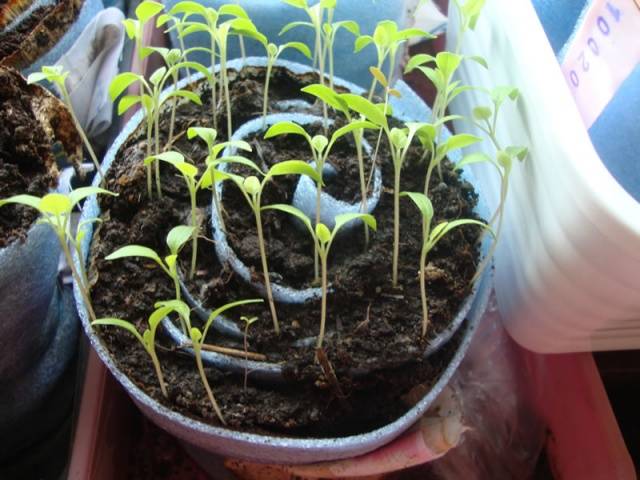

And the video below will help those gardeners who are using this method of planting tomatoes for the first time to cope with the work: - When two or three real leaves appear, a pick is carried out into separate cups with a volume of at least 500 ml. In smaller containers, the plants will feel uncomfortable, which will negatively affect the seedlings.
- Before planting in a permanent place, glasses of Siberian tiger tomatoes are taken out into the fresh air for hardening. Tomatoes that are ready for planting have a bluish tint to the stems.
Planting and care in the ground
The ground for tomatoes is prepared in the fall. It is fertilized, dug up. If for some reason the work was not completed, then you can do it in the spring.
After preparing the holes, each is spilled with a pink solution of potassium permanganate (boiling water), a handful of wood ash is added.
The distance between the plants is at least 50 cm, because only 4 tomatoes are planted per square meter. The seedlings should not be deeply buried, otherwise the vegetative period will last. The fruits will ripen two weeks later.
Attention! Thickened planting of tomatoes leads to loss of yield, since the plants will not have enough light and air.
Immediately after planting, the seedlings are spilled and the soil is mulched. Be sure to cut off the lower leaves and stepchildren before the first fork. Form a bush in a greenhouse into one or two stems. In the open field, you can leave 2-3. In the future, they remove all the stepsons and pinch the leaves under the tied brushes.This will provide light access and facilitate air circulation.
Further care for Siberian Tiger tomatoes comes down to traditional actions:
- watering, loosening, weeding;
- feeding tomatoes;
- preventive measures against diseases.
Siberian tiger tomatoes are recommended to be fed with organic fertilizers.
When the bush grows to the ceiling of the greenhouse, the stems are pinched. Such an operation allows you to redistribute nutrients that will begin to work on the formation and maturation of the crop.
The best reviews from our readers
- Irina
City: Olonets, KareliaManufacturer: Finland
Where they grew up: Greenhouse
They look great on the table, decorate the greenhouse from the moment the fruits appear from watermelon greens to red-raspberry when ripe. Tastes good too.
- Hope
City: SPbWhere they grew up: Greenhouse
Nice, fruitful, ordinary taste. Better to plant outdoors (it is brighter there)
- Raya
City: ShumikhaManufacturer: gavrish
Where it was grown: Open ground
The bushes are large. Pleasant sweetish taste of tomatoes, high-yielding (about a bucket from a bush), very good, tasty thick raspberry juice. When pickled, mature ones are rather weak, crack, green-brown in salting, very beautiful and tasty. Keeping quality is average. In June - early July, it requires the prevention of fungal diseases (green fruits crack, become covered with brown stripes, leaves are stained)
Tomato tiger reviews




